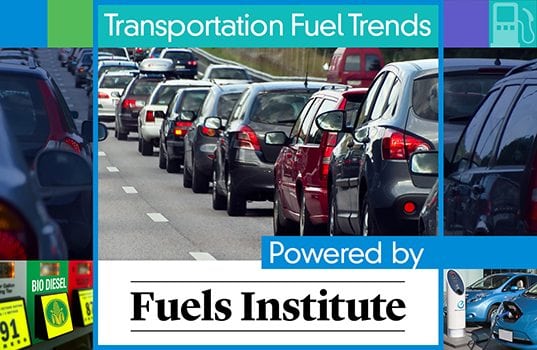By John Eichberger
[Editorial Note: This article ran previously in the July issue of NACS Magazine]
For years, the media has touted the benefits of an electric drive transportation future and the automotive industry has invested billions in battery research and development. At both the federal and state levels, government agencies have created incentives for the production and purchase of EVs in an attempt to break the United States from its oil addiction. Amid all this lies the question: Are electric vehicles (EVs) a threat or opportunity for fuel retailers?
Reality speaking, they’re likely neither. For all the attention, the market rate of development and the technical attributes of batteries suggest that EVs will not significantly change the fuel retailing market any time soon. Concern and interest is warranted, however.
Sales of EVs
The market for EVs (defined here as plug-in hybrids and battery electric vehicles, or BEVs) is obviously growing. The number of EVs for sale is significantly higher than it was just a few years ago. According to Green Car Reports, through May 2014, American consumers purchased more than 37,000 units. In the next few years, several new EV models are expected to enter the market, including those manufactured by luxury automaker brands, entrants that could expand the potential market for these vehicles.
Car Reports, through May 2014, American consumers purchased more than 37,000 units. In the next few years, several new EV models are expected to enter the market, including those manufactured by luxury automaker brands, entrants that could expand the potential market for these vehicles.
However, the sale of EVs represents a very small percentage of total U.S. light duty vehicle sales, which according to WardsAuto, totaled 6.74 million through May 2014. Despite strong EV sales through the early part of this year, EVs aren’t posing a significant threat to traditional fueling outlets.
Battery Technology
Among the limiting factors of current EVs are their batteries, namely their limited range on a full charge and the slow rate of recharging. The composition and configuration of an EV battery pack can influence its range and its capacity to accept a rapid recharge. Early hybrids used a nickel-metal hydride battery — the Toyota Prius continues to do so — but most models have shifted to the lighter weight lithium ion battery.
According to recent numbers published by Navigant Research, lithium ion battery production is expected to increase ten-fold by 2020 and sales are expected to increase from $3.2 billion to $24.1 billion by 2023. But can these batteries provide consumers with the range and recharging experience they need to abandon gasoline-powered vehicles? To be on par with gasoline vehicles, an EV needs to deliver 300 to 400 miles per charge and be capable of full recharge in under 10 minutes. Is such a breakthrough likely?
Battery packs combine a number of battery cells, connected either in series or parallel or both. Each configuration carries with it certain benefits — serial connections combine the voltage output of each cell in the series, whereas the parallel connections boost the amperage but maintain the voltage of the individual cell. To boost power and range, battery packs can adjust the connection configurations and increase the number of cells.
While the range of a vehicle is critical, consumers are very interested in recharging time, especially since current charging options remain limited. A standard 110-volt wall outlet can take more than eight hours to deliver a full charge (to a 40-mile range battery), averaging about 4.5 miles per hour of charging. The more common application, a Level 2 charger, delivers power through a 240-volt system and can improve the delivery rate to approximately 26 miles per hour. The DC Fast Charge carries 400 to 600 volts and can deliver up to 40 miles per 10 minutes, but its use in vehicles in limited.
The leading EV in terms of range and recharge time is the Tesla Model S, which can deliver a range of more than 250 miles per charge, and when connected to the proprietary supercharger can recharge 50% within 30 minutes. A combination of more than 7,000 lithium ion battery packs is connected in series and parallel configurations. The supercharger can deliver up to 400 volts at 250 amps and the battery pack is configured to accept that rate of re-charge safely.
The Tesla Model S is a significant step forward, but can a battery be developed to deliver a 300-mile range within 10 minutes of recharging? Currently, it doesn’t appear likely. However, even if a breakthrough were achieved, it may not matter. The U.S. electricity grid is incapable of delivering the power necessary to achieve such recharging rates without incorporating on-site power boosting systems, which would make the installation unaffordable for most locations. Further, if a significant number of EVs attempted to tap into this system at the same time, the grid couldn’t sustain the demand despite the use of in-market boosters.
Effect on Fuel Retailers
Ultimately, the primary target market for EVs are consumers who commute 40 miles or less each day. These consumers can recharge overnight at home or — if lucky — plug in at work, but their need for in-transit recharging at a convenience store will be highly limited.
The concept that consumers will stop at convenience stores to recharge their vehicles on a regular basis isn’t realistic, at least with existing technology. The rate of recharge and the range delivered are not acceptable to consumers and this will continue to limit acceptance of these vehicles — unless the commuting distance is within the range of the battery on a single charge.
The bottom line for retailers is this:
- EVs currently represent less than half of 1% of new vehicle sales.
- The U.S. Energy Information Administration forecast that BEVs and plug-ins will represent no more than 1.5% of light duty vehicles on the road in 2040.
- EV consumers will predominantly be those whose daily commute does not require in-transit recharging.
While neither a threat nor an opportunity for retailers at the time, as the EV market develops, it is appropriate and essential for retailers to reevaluate the situation.
 For more information about the Fuels Institute or how you can get involved, contact John Eichberger, executive director, at [email protected] or (703)518-7971. The Fuels Institute Annual Meeting is November 17-19, in Southern California. You are invited to register for this open meeting and we are planning a fantastic agenda. In addition to discussions on key issues facing the transportation fuels market, we will also be visiting retail facilities that dispense hydrogen and natural gas, as well as visit with experts at Toyota to learn more about advanced vehicle technologies. Registration information will be available in the near future. In the meantime, join the conversation online at Facebook and Twitter. By sharing information and opinions with one another, we can create a sustainable transportation fuels market.
For more information about the Fuels Institute or how you can get involved, contact John Eichberger, executive director, at [email protected] or (703)518-7971. The Fuels Institute Annual Meeting is November 17-19, in Southern California. You are invited to register for this open meeting and we are planning a fantastic agenda. In addition to discussions on key issues facing the transportation fuels market, we will also be visiting retail facilities that dispense hydrogen and natural gas, as well as visit with experts at Toyota to learn more about advanced vehicle technologies. Registration information will be available in the near future. In the meantime, join the conversation online at Facebook and Twitter. By sharing information and opinions with one another, we can create a sustainable transportation fuels market.









